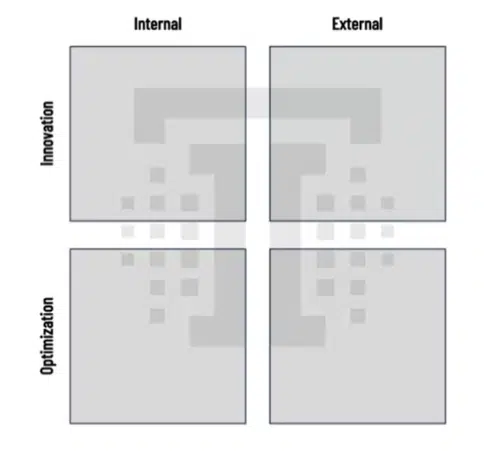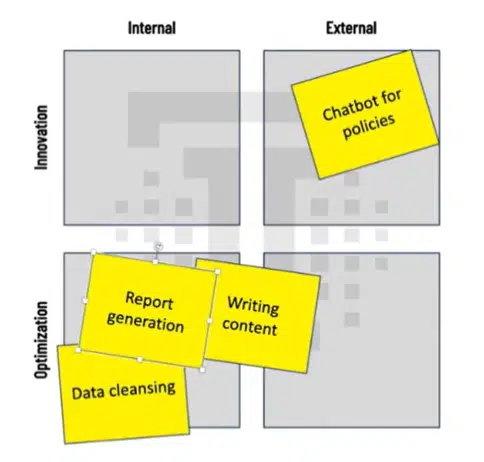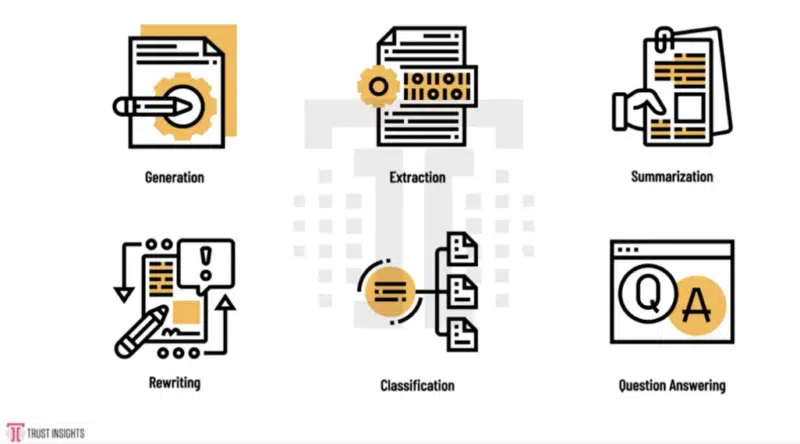Evaluating which generative AI tools are right for your company isn’t easy. To help with that process, Trust Insights’s CEO and co-founder Katie Robbert, and co-founder/Chief Data Scientist Christopher Penn, have created a two-by-two matrix for executives, which they outlined in a recent video.
“Every job will be impacted in some way by large language models and generative AI,” said Penn. “The challenge is for executives, decision-makers and leaders to figure out the use cases and categories, and map them to their organization.”
Why we care. Organizations are at different stages of digital maturity and use AI for different functions. The two-by-two matrix helps marketing leaders determine how generative AI tools work in their company’s processes, and whether the tools optimize existing functions or introduce entirely new processes in the organization. Knowing this, decision-makers can prioritize which tools to add and how to implement them.
2×2 matrix. The two-by-two matrix helps organizations reach a decision by measuring two factors against each other. It allows organizations to compare tools that optimize against tools that innovate.

“We’re focusing on if this use case will optimize what we do — make it faster, more efficient, make the processes more automated and repeatable — versus innovation, which tends to be a new spin on something we’re already doing or something we’ve never done before,” said Robbert.
“Is it making something that exists already better, which is optimization, or is it bringing something new to the table?” asked Penn.
Their two-by-two matrix also separates tools used internally versus public-facing processes.
GenAI use cases. These use cases depend on how you will use the tools. Different organizations may place the same tools in different areas of the matrix because they are using them for different processes. A content tool might be innovative (entirely new) for an organization that doesn’t regularly produce blog posts or other content. However, for an organization that regularly produces content, a new genAI tool optimizes the existing process.

Here are some examples of generative AI use cases and where they might fall on the matrix:
- Chatbot for policies: An insurance company might use a chatbot to help explain policies to customers, adding some automation to customer service.
- Content writing: Affects the way content gets produced by internal teams, but is also public-facing because customers read it.
- Data cleansing: Optimizing a process that limits the rest of an org’s data-driven functions data cleansing is done manually.
- Report generation: Summarizing insights from data analysis in reports.
Once these cases are graphed on the matrix, organizations can identify the ones that will address urgent needs.
Use case categories. To help identify potential use cases for your organization, here is a list of six main generative AI categories.

- Generation: Creating text and images for blog posts, emails and other digital media.
- Extraction: Getting data out of a document or other data source without having a human read over it line-by-line.
- Summarization: Taking a large document or transcript and as the AI to summarize for key points.
- Rewriting: Taking an existing document or other piece of content and asking genAI to take the information and reframe it in another style, for another purpose.
- Classification: Identifying blocks of text and classifying them.
- Answering questions: Ask the AI about a document it has ingested. For instance, does a legal contract favor one party over another?
Each category includes multiple tools. Knowing the categories will help decision-makers identify what use cases their org can benefit from, and where to start in their search for adopting a new tool.
Dig deeper: This week’s AI-powered martech releases
Get MarTech! Daily. Free. In your inbox.

